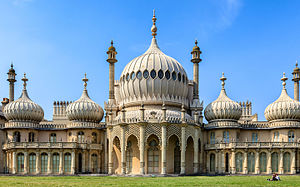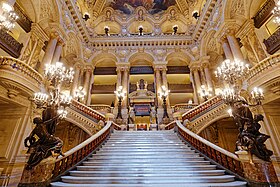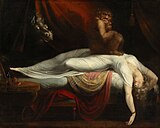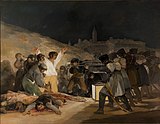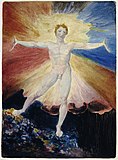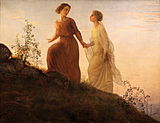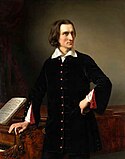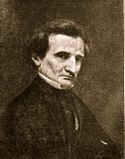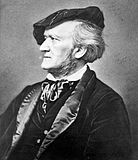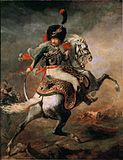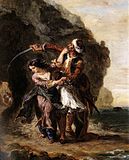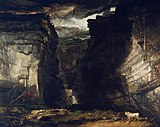User:Erroramong/sandbox


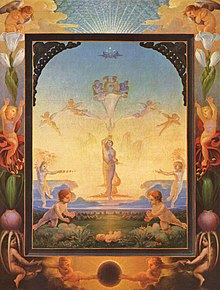
Romanticism (also known as the Romantic movement or Romantic era) was an artistic and intellectual movement that originated in Europe towards the end of the 18th century. The purpose of the movement was to advocate for the importance of subjectivity, imagination, and appreciation of nature in society and culture during the Age of Enlightenment and the Industrial Revolution.
Romanticists rejected the social conventions of the time in favor of a moral outlook known as individualism. They argued that passion and intuition were crucial to understanding the world, and that beauty is more than merely an affair of form but rather something that evokes a strong emotional response. With this philosophical foundation, the Romanticists elevated a number of key themes to which they were deeply committed: a reverence for nature and the supernatural, an idealization of the past as a nobler era, a fascination with the exotic and the mysterious, and a celebration of the heroic and the sublime.
The Romanticist movement had a particular fondness for the medieval period, which to them represented an era of chivalry, heroism, and a more organic relationship between humans and their environment. This idealization contrasted sharply with the values of their contemporary industrial society, which they considered alienating for its materialism and environmental degradation. The movement's illustration of the middle ages was a key theme in debates, with allegations that Romanticist portrayals often overlooked the downsides of medieval life.
The consensus is that Romanticism peaked from 1800-1850. However, a "Late Romantic" period and "Neoromantic" revivals are also discussed. These extensions of the movement are characterized by a resistance to the increasingly experimental and abstract forms that culminated in modern art, and the deconstruction of traditional tonal harmony in music. They continued the Romantic ideal, stressing depth of emotion in art and music while showcasing technical mastery in a mature Romantic style. By the time of World War I though, the cultural and artistic climate had changed to such a degree that Romanticism essentially dispersed into subsequent movements. The final Late Romanticist figures to maintain the Romantic ideals died in the 1940s and though they were still widely respected, they were seen as anachronisms at that point.
Romanticism was a complex movement, with a variety of viewpoints that permeated Western civilization across the globe. The movement and its opposing ideologies mutually shaped each other as time went on. After its end, Romantic thought and art exerted a sweeping influence on art and music, speculative fiction, philosophy, politics, and environmentalism that has endured into the present day.
The movement is the reference for the modern notion of "romanticization" and the act of "romanticizing" something.
Overview[edit]
Timeline[edit]
For most of the Western world, Romanticism was at its peak from approximately 1800 to 1850. The first Romantic ideas arose from an earlier German Counter-Enlightenment movement called Sturm und Drang (German: "Storm and Stress"). This movement directly criticized the Enlightenment's position that humans can fully comprehend the world through rationality alone, suggesting that intuition and emotion are key components of insight and understanding.[1] Published in 1774, "The Sorrows of Young Werther" by Johann Wolfgang von Goethe began to shape the Romanticist movement and it's ideals. The events and ideologies of the French Revolution were also direct influences on the movement; many early Romantics throughout Europe sympathized with the ideals and achievements of French revolutionaries.[2]
A confluence of circumstances lead to Romanticism's decline in the mid-19th century, including (but not limited to) the rise of Realism and Naturalism, Charles Darwin's publishing of the Origin of Species, the transition from widespread revolution in Europe to a more conservative climate, and a shift in public consciousness to the immediate impact of technology and urbanization on the working class. Additionally, the 1840s saw a significant wave of deaths of titanic Romanticist celebrities, including but not limited to William Wordsworth, José de Espronceda, Frederic Chopin, and Edgar Allen Poe.
However, it has had a lasting impact on Western civilization, and many works of art, music, and literature that embody the Romantic ideals have been made after end of the Romantic Era. The movement's advocacy for nature appreciation is cited as an influence for current nature conservation efforts. The majority of film scores from the Golden Age of Hollywood were written in the lush orchestral Romantic style, and this genre of orchestral cinematic music is still often seen in movies today. The philosophical underpinnings of the movement has influenced modern political theory, both among liberals and conservatives.
Purpose[edit]
Romanticism was characterized by its emphasis on emotion and individualism as well as glorification of the past and nature, preferring the medieval over the classical. Romanticism was partly a reaction to the Industrial Revolution,[3] and the prevailing ideology of the Age of Enlightenment, especially the scientific rationalization of Nature.[4] It was embodied most strongly in the visual arts, music, and literature; it also had a major impact on historiography,[5] education,[6] chess, social sciences, and the natural sciences.[7] It had a significant and complex effect on politics: Romantic thinking influenced conservatism, liberalism, radicalism, and nationalism.[8][9]
Romanticism prioritized the artist's unique, individual imagination above the strictures of classical form. The movement emphasized intense emotion as an authentic source of aesthetic experience. It granted a new importance to experiences of sympathy, awe, wonder, and terror, in part by naturalizing such emotions as responses to the "beautiful" and the "sublime".[10][11]
Romantics stressed the nobility of folk art and ancient cultural practices, but also championed radical politics, unconventional behavior, and authentic spontaneity. In contrast to the rationalism and classicism of the Enlightenment, Romanticism revived medievalism[12] and juxtaposed a pastoral conception of a more "authentic" European past with a highly critical view of recent social changes, including urbanization, brought about by the Industrial Revolution. Romanticism lionized the achievements of "heroic" individuals – especially artists, who began to be represented as cultural leaders (one Romantic luminary, Percy Bysshe Shelley, described poets as the "unacknowledged legislators of the world" in his "Defence of Poetry").
After 1850[edit]

Postromanticism is a concept that encompasses the spectrum of Romanticist influence which began or continued after the High Romantic Era. This time period is most commonly recognized to begin at about 1850, when irreconcilable disagreements first arose about how the Romantic ideal should carry forward, and the broadest definiton of the term includes all Romantic inspiration up to and including the present day.
Continuation of Romanticism[edit]

The Romanticist movement began to lose intellectual clout after 1850, though figures like John Ruskin and Ralph Waldo Emerson kept Romantic ideas relevant to the problems of post-1850 society. Friedrich Nietzsche is also considered a Romantic-influenced thinker, although his ideas were misrepresented by his sister after his death and he was not properly understood until the 20th century.
In literature and visual art, Realism emerged as a reaction to Romanticism and became dominant in these mediums. Realist authors such as Gustav Flaubert and Charles Dickens showcased a style that was considered more relevant to society's issues at the time. However, the Romantic movement nevertheless carried a colossal artistic momentum in the following decades. Victor Hugo, author of Les Miserables and The Hunchback of Notre Dame, held a towering stature in the public eye up right up until his death: his funeral in 1885 was attended by over 2 million people, the largest in French history.
In music, the most significant figure in extending the Romantic era beyond 1850 was the conductor Hans von Bülow. Through his widespread notoriety, he was pivotal in promoting post-1850 Romantic composers such as Johannes Brahms and Richard Wagner. Hans von Bülow also played a crucial role in the conducting careers of Bruno Walter and Gustav Mahler, who both also championed Romantic music. More broadly, the musical community was so successful in maintaining a coherent Romantic identity that musicologists often defy the timelines set by historians in other mediums, marking the end of the Romantic era at 1910. In consideration of the broader Romantic movement though, a distinction is made between the "Early Romantic" (1800-1830), "High Romantic" (1830-1850) and "Late Romantic" (1850-1910).
For the other artistic mediums though, the terminology used is a bit looser. Literary historians might refer to a book with ambiguous labels such as "containing Romantic themes" or "in the Romantic tradition".
Dispersion[edit]

Though Romanticism still was at the forefront of Western Civilization's consciousness, the demand for innovation in art caused the movement to "disperse" into subsequent movements that took parts of Romanticism and incorporated them into new forms. This transition is called the Postromantic Period, and overlaps with figures who adhered more strictly to the Romantic tradition. There was significant cultural tension and disagreement surrounding how the ideals of the Romantic movement should be carried forward.
The first post-1850 movement to evolve Romantic principles was the Pre-Raphaelites. Founded in 1848, the movement had very specific, pointed technical concerns related to visual art that they advocated for, among which was a criticism of Classicist Rennaissance artists such as Michaelangelo and Raphael. The movement advocated for a return to the sensibilities of medieval and early Renaissance art, with a particular advocacy for the virtues of the Quattrocento period to which Leonardo da Vinci belonged to.
The original wave of the movement only lasted for about four years and was embroiled in controversy, having a particularly contentious relationship with the orthodoxy at the English Royal Academy of the Arts. Due to artistic disagreements, the group subsequently split throughout the 1850s into two camps — the "realists", who focused on accurate depictions; and the "medievalists", who infused their art with vibrant colors and embraced the Romantic idealization of the Middle Ages with spiritualist and symbolic themes. While these terms both refer to broader preexisting movements, the labels carry specific connotations for the Pre-Raphaelites. This fracture, along with the Pre-Raphaelites conflicts with the broader art world, was indicative of the artistic disagreements about how to best carry forward the principles of the Romantic era.
The symbolic elements of the medievalist Pre-Raphaelites culmiated in the Symbolist movement. Symbolism was a reaction to Realism that found its origin in the publishing of Charles Baudelaire's Le Fleurs du Mal, a work which was censored substantially at the time of its publication due to immorality concerns. The aims of Symbolism surrounded a desire or angst to "break out" of the surface appearance of things, launching into mystical and transcendent themes through elements called "symbols". This allowed the artist to communicate their inner worlds, a motivation that came from the Romanticists' advocacy for subjectivity. Symbolism's proponents saw the movement as a logical "spiritual successor" to Romanticism for this reason.

In the 1870s came Impressionism. This movement in the visual arts evolved from Realism, but with new methods by painters who aimed to portray scenes based on the first fleeting split-second glimpse the eye captures. They believed that their approach allowed a painting to highlight the perceptive and emotional quality of a scene — the scene's "impression" — that is decluttered from the subject's detailed content. This continued the Romantic sentiment of the artist communicating their subjectivity to the audience. However, Impressionism maintained a Realist resistance to the dramatic sensibilities of the Romantics such as the heroic and the exotic, preferring to communicate their impressions of profound beauty in ordinary, everyday life.
Modernist transition[edit]

A key moment of the dispersion of the Romantic movement is the transition to Modernism in mainstream culture. The transition was shaped largely by societal events — for example, Postromanticism gained significant momentum in the United States following the American Civil War.
A pivotal movement in the visual arts for this period is Expressionism. Expressionists focused on inner emotions and psychological states, often using distorted forms and jarring colors to convey the turmoil and anxiety of the individual psyche and societal issues. This approach reflects a less idealized and more confrontational and introspective reaction to the modern world. Additionally, Symbolism deemphasized nature to an even greater degree than Impressionism and Symbolism, marking a more significant departure from strict Romantic ideals.
Some artistic figures during the Postromantic era can be difficult to categorize due to their eclecticness. The Postromantic composer Claude Debussy,[13] for example, was described as an Impressionist but he himself rejected the term, complaining that it was foisted on him by critics who are overly focused on categorizations. His late career also involved modernist experimentation, but his Romantic influences remained palpable and he outspokenly admired the Romanticists — particularly Chopin, saying: "Chopin is the greatest of all, for with the piano alone he discovered everything."
Another peculiar mention in Postormantic music is Ralph Vaughan Williams. An example of Romantic Nationalism combined with musical experimentation, the key focus of his career was his attempt to retroactively remove the pervasive Teutonic influence in Western music that was imbued by composers such as Bach, Haydn, Mozart, and Beethoven. Fantasia on a Theme by Thomas Tallis, one of Vaughan Williams most well-known compositions, exemplifies this endeavor. The music is a modification of a tune from Elizabethan times, before the influences of the Common Practice Period.
The Irish poet William Butler Yeats also stands out in this transitory period for his innovative early work that is infused with Romantic themes, including mysticism, the supernatural, and a profound connection to Irish mythology and folklore. Even with this heavy Romantic influence, he transitioned to a more Realist style after about 1900.
Interwar era[edit]

World War I was particularly relevant to the decline of Late Romanticism and the rise of Modernism. It was a cataclysmic event that profoundly changed societal values, philosophies, and the arts, leading to a stark reevaluation of Romantic ideals in the face of modern warfare's realities. The war also followed the death of Gustav Mahler, an event that is often cited as a marker for the end of the Late Romantic era by musicologists. Referring to anyone as "Late Romantic" thus becomes harder to defend after the 1910s, with the "Neoromantic" label being much more common.
However, a handful of figures in art and music that were active before the 1910s and maintained their style into the interwar period have been characterized as Late Romantic. The composers Sergei Rachmaninoff, Richard Strauss, and Jean Sibelius continued to create works in the Romantic ethos — characterized by emotional depth, complex harmonies, and a strong narrative element — at a time when the musical world was increasingly turning towards abstraction and experimentation associated with modernism. Though considered out of phase with the current trends, their work was well respected.
Also during the interwar period was an enduring interest in the earlier Romantic music. In 1927, the International Chopin Piano Competition was founded to celebrate the music of the eponymous composer. The pianist Vladimir Horowitz reached immense popularity for his awesome technical command as he performed music of the Romantic era. Horowitz's highly publicized personal life, including his defection from the Soviet Union and dramatized return for performances, were part of his portrayal as a modern-day Romantic figure during his life.
Post-WWII[edit]
The label "Neoromantic" is used for artists and thinkers, both of Romantic and Postromantic sensibilities, who the term "Late Romantic" does not apply to because their careers took place after the movement no longer had a cohesive identity. Though the Neoromantic label is also applied to figures in the interwar period, the end of World War II is nevertheless a significant event in the timeline of Neoromanticism as Western civilization returned to normalcy after several years of total war. The careers of Neoromantic composers saw a significant boost during this period.
In music, an influential Neoromanticist figure in the 20th century music was Leopold Stokowski, perhaps best known today as the conductor in Disney's Fantasia. Stokowski and others such as Leonard Bernstein revived interest in Mahler's compositions in the West. Born to Jewish parents, Mahler had been banned in middle-European countries during the Nazi era, and was generally less well known abroad.
Stokowski wrote grand orchestral transcriptions of Johann Sebastian Bach's organ works, most notably the Toccata and Fugue in D Minor and the Passacaglia and Fugue in C Minor. Of the Toccata, Gramophone Magazine said: ""one of the most exciting achievements of the American orchestra ... the only word is 'magnificent.'".[14] Some critics complained though that he was overly unrestrained in his transcriptions — a common criticism of Romanticist artists. These performances, continuing the thread woven by Felix Mendelsohn's watershed performance of Bach's St. Matthew Passion, shaped public perception of Bach as a "proto-Romantic" figure whose music foreshadowed the emotional depth of the Romantic period.
Perhaps the best-known Neoromanticist literary work is the Lord of the Rings trilogy by J.R.R. Tolkien, published in 1954. Though there has been some controversy of applying the label due to Tolkien's outspoken criticisms certain aspects of the Romantic movement, the characterization of his work as Neoromanticist gained significant traction through the 2010s and 2020s.[15]
Orchestral music in the Romantic style was a staple of the Golden Age of Hollywood Cinema, and Romanticism's continued influence on cinema music is seen in later decades. John Williams in particular embraced a Romantic style in his works. Williams' music is known for the widespread usage of melodies for individual characters and settings, a stylistic approach referred to by musicologists as leitmotif that originated in the Romantic era.
Defining Romanticism[edit]
Basic characteristics[edit]
Romanticism placed the highest importance on the freedom of the artist to authentically express their sentiments and ideas. Romantics like the German painter Caspar David Friedrich believed that an artist's emotions should dictate their formal approach; Friedrich went as far as declaring that "the artist's feeling is his law".[16] The Romantic poet William Wordsworth, thinking along similar lines, wrote that poetry should begin with "the spontaneous overflow of powerful feelings", which the poet then "recollect[s] in tranquility", enabling the poet to find a suitably unique form for representing such feelings.[17]
The Romantics never doubted that emotionally motivated art would find suitable, harmonious modes for expressing its vital content—if, that is, the artist steered clear of moribund conventions and distracting precedents. Samuel Taylor Coleridge and others thought there were natural laws the imagination of born artists followed instinctively when these individuals were, so to speak, "left alone" during the creative process.[18] These "natural laws" could support a wide range of different formal approaches: as many, perhaps, as there were individuals making personally meaningful works of art. Many Romantics believed that works of artistic genius were created "ex nihilo", "from nothing", without recourse to existing models.[19][20][21] This idea is often called "romantic originality".[22] Translator and prominent Romantic August Wilhelm Schlegel argued in his Lectures on Dramatic Arts and Letters that the most valuable quality of human nature is its tendency to diverge and diversify.[23]
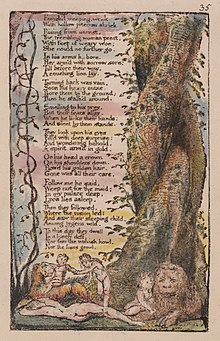
According to Isaiah Berlin, Romanticism embodied "a new and restless spirit, seeking violently to burst through old and cramping forms, a nervous preoccupation with perpetually changing inner states of consciousness, a longing for the unbounded and the indefinable, for perpetual movement and change, an effort to return to the forgotten sources of life, a passionate effort at self-assertion both individual and collective, a search after means of expressing an unappeasable yearning for unattainable goals".[24]
Romantic artists also shared a strong belief in the importance and inspirational qualities of Nature. Romantics were distrustful of cities and social conventions. They deplored Restoration and Enlightenment Era artists who were largely concerned with depicting and critiquing social relations, thereby neglecting the relationship between people and Nature. Romantics generally believed a close connection with Nature was beneficial for human beings, especially for individuals who broke off from society in order to encounter the natural world by themselves.
Romantic literature was frequently written in a distinctive, personal "voice". As critic M. H. Abrams has observed, "much of romantic poetry invited the reader to identify the protagonists with the poets themselves."[25] This quality in Romantic literature, in turn, influenced the approach and reception of works in other media; it has seeped into everything from critical evaluations of individual style in painting, fashion, and music, to the auteur movement in modern filmmaking.
Etymology[edit]
The group of words with the root "Roman" in the various European languages, such as "romance" and "Romanesque", has a complicated history. By the 18th century, European languages – notably German, French and Slavic languages – were using the term "Roman" in the sense of the English word "novel", i.e. a work of popular narrative fiction.[26] This usage derived from the term "Romance languages", which referred to vernacular (or popular) language in contrast to formal Latin.[26] Most such novels took the form of "chivalric romance", tales of adventure, devotion and honour.[27]
The founders of Romanticism, critics (and brothers) August Wilhelm Schlegel and Friedrich Schlegel, began to speak of romantische Poesie ("romantic poetry") in the 1790s, contrasting it with "classic" but in terms of spirit rather than merely dating. Friedrich Schlegel wrote in his 1800 essay Gespräch über die Poesie ("Dialogue on Poetry"):
- I seek and find the romantic among the older moderns, in Shakespeare, in Cervantes, in Italian poetry, in that age of chivalry, love and fable, from which the phenomenon and the word itself are derived.[28][29]
The modern sense of the term spread more widely in France by its persistent use by Germaine de Staël in her De l'Allemagne (1813), recounting her travels in Germany.[30] In England Wordsworth wrote in a preface to his poems of 1815 of the "romantic harp" and "classic lyre",[30] but in 1820 Byron could still write, perhaps slightly disingenuously,
- I perceive that in Germany, as well as in Italy, there is a great struggle about what they call 'Classical' and 'Romantic', terms which were not subjects of classification in England, at least when I left it four or five years ago.[31]
It is only from the 1820s that Romanticism certainly knew itself by its name, and in 1824 the Académie française took the wholly ineffective step of issuing a decree condemning it in literature.[32]
Period[edit]
The period typically called Romantic varies greatly between different countries and different artistic media or areas of thought. Margaret Drabble described it in literature as taking place "roughly between 1770 and 1848",[33] and few dates much earlier than 1770 will be found. In English literature, M. H. Abrams placed it between 1789, or 1798, this latter a very typical view, and about 1830, perhaps a little later than some other critics.[34] Others have proposed 1780–1830.[35] In other fields and other countries the period denominated as Romantic can be considerably different; musical Romanticism, for example, is generally regarded as only having ceased as a major artistic force as late as 1910, but in an extreme extension the Four Last Songs of Richard Strauss are described stylistically as "Late Romantic" and were composed in 1946–48.[36] However, in most fields the Romantic period is said to be over by about 1850, or earlier.
The early period of the Romantic era was a time of war, with the French Revolution (1789–1799) followed by the Napoleonic Wars until 1815. These wars, along with the political and social turmoil that went along with them, served as the background for Romanticism.[37] The key generation of French Romantics born between 1795 and 1805 had, in the words of one of their number, Alfred de Vigny, been "conceived between battles, attended school to the rolling of drums".[38] According to Jacques Barzun, there were three generations of Romantic artists. The first emerged in the 1790s and 1800s, the second in the 1820s, and the third later in the century.[39]
Context and place in history[edit]
The more precise characterization and specific definition of Romanticism has been the subject of debate in the fields of intellectual history and literary history throughout the 20th century, without any great measure of consensus emerging. That it was part of the Counter-Enlightenment, a reaction against the Age of Enlightenment, is generally accepted in current scholarship. Its relationship to the French Revolution, which began in 1789 in the very early stages of the period, is clearly important, but highly variable depending on geography and individual reactions. Most Romantics can be said to be broadly progressive in their views, but a considerable number always had, or developed, a wide range of conservative views,[40] and nationalism was in many countries strongly associated with Romanticism, as discussed in detail below.
In philosophy and the history of ideas, Romanticism was seen by Isaiah Berlin as disrupting for over a century the classic Western traditions of rationality and the idea of moral absolutes and agreed values, leading "to something like the melting away of the very notion of objective truth",[41] and hence not only to nationalism, but also fascism and totalitarianism, with a gradual recovery coming only after World War II.[42] For the Romantics, Berlin says,
in the realm of ethics, politics, aesthetics it was the authenticity and sincerity of the pursuit of inner goals that mattered; this applied equally to individuals and groups—states, nations, movements. This is most evident in the aesthetics of romanticism, where the notion of eternal models, a Platonic vision of ideal beauty, which the artist seeks to convey, however imperfectly, on canvas or in sound, is replaced by a passionate belief in spiritual freedom, individual creativity. The painter, the poet, the composer do not hold up a mirror to nature, however ideal, but invent; they do not imitate (the doctrine of mimesis), but create not merely the means but the goals that they pursue; these goals represent the self-expression of the artist's own unique, inner vision, to set aside which in response to the demands of some "external" voice—church, state, public opinion, family friends, arbiters of taste—is an act of betrayal of what alone justifies their existence for those who are in any sense creative.[43]
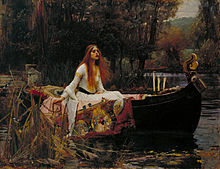
Arthur Lovejoy attempted to demonstrate the difficulty of defining Romanticism in his seminal article "On The Discrimination of Romanticisms" in his Essays in the History of Ideas (1948); some scholars see Romanticism as essentially continuous with the present, some like Robert Hughes see in it the inaugural moment of modernity,[44] while writers of the 19th Century such as Chateaubriand, Novalis and Samuel Taylor Coleridge saw it as the beginning of a tradition of resistance to Enlightenment rationalism—a "Counter-Enlightenment"—[45][46] to be associated most closely with German Romanticism. Another early definition comes from Charles Baudelaire: "Romanticism is precisely situated neither in choice of subject nor exact truth, but in the way of feeling."[47]
The end of the Romantic era is marked in some areas by a new style of Realism, which affected literature, especially the novel and drama, painting, and even music, through Verismo opera. This movement was led by France, with Balzac and Flaubert in literature and Courbet in painting; Stendhal and Goya were important precursors of Realism in their respective media. However, Romantic styles, now often representing the established and safe style against which Realists rebelled, continued to flourish in many fields for the rest of the century and beyond. In music such works from after about 1850 are referred to by some writers as "Late Romantic" and by others as "Neoromantic" or "Postromantic", but other fields do not usually use these terms; in English literature and painting the convenient term "Victorian" avoids having to characterise the period further.
In northern Europe, the Early Romantic visionary optimism and belief that the world was in the process of great change and improvement had largely vanished, and some art became more conventionally political and polemical as its creators engaged polemically with the world as it was. Elsewhere, including in very different ways the United States and Russia, feelings that great change was underway or just about to come were still possible. Displays of intense emotion in art remained prominent, as did the exotic and historical settings pioneered by the Romantics, but experimentation with form and technique was generally reduced, often replaced with meticulous technique, as in the poems of Tennyson or many paintings. If not realist, late 19th-century art was often extremely detailed, and pride was taken in adding authentic details in a way that earlier Romantics did not trouble with. Many Romantic ideas about the nature and purpose of art, above all the pre-eminent importance of originality, remained important for later generations, and often underlie modern views, despite opposition from theorists.
Literature[edit]


In literature, Romanticism found recurrent themes in the evocation or criticism of the past, the cult of "sensibility" with its emphasis on women and children, the isolation of the artist or narrator, and respect for nature. Furthermore, several romantic authors, such as Edgar Allan Poe, Charles Maturin and Nathaniel Hawthorne, based their writings on the supernatural/occult and human psychology. Romanticism tended to regard satire as something unworthy of serious attention, a view still influential today.[48] The Romantic movement in literature was preceded by the Enlightenment and succeeded by Realism.
Some authors cite 16th-century poet Isabella di Morra as an early precursor of Romantic literature. Her lyrics covering themes of isolation and loneliness, which reflected the tragic events of her life, are considered "an impressive prefigurement of Romanticism",[49] differing from the Petrarchist fashion of the time based on the philosophy of love.
The precursors of Romanticism in English poetry go back to the middle of the 18th century, including figures such as Joseph Warton (headmaster at Winchester College) and his brother Thomas Warton, Professor of Poetry at Oxford University.[50] Joseph maintained that invention and imagination were the chief qualities of a poet. The Scottish poet James Macpherson influenced the early development of Romanticism with the international success of his Ossian cycle of poems published in 1762, inspiring both Goethe and the young Walter Scott. Thomas Chatterton is generally considered the first Romantic poet in English.[51] Both Chatterton and Macpherson's work involved elements of fraud, as what they claimed was earlier literature that they had discovered or compiled was, in fact, entirely their own work. The Gothic novel, beginning with Horace Walpole's The Castle of Otranto (1764), was an important precursor of one strain of Romanticism, with a delight in horror and threat, and exotic picturesque settings, matched in Walpole's case by his role in the early revival of Gothic architecture. Tristram Shandy, a novel by Laurence Sterne (1759–67), introduced a whimsical version of the anti-rational sentimental novel to the English literary public.
Architecture[edit]
Romantic architecture appeared in the late 18th century in a reaction against the rigid forms of neoclassical architecture. Romantic architecture reached its peak in the mid-19th century, and continued to appear until the end of the 19th century. It was designed to evoke an emotional reaction, either respect for tradition or nostalgia for a bucolic past. It was frequently inspired by the architecture of the Middle Ages, especially Gothic architecture, it was strongly influenced by romanticism in literature, particularly the historical novels of Victor Hugo and Walter Scott. It sometimes moved into the domain of eclecticism, with features assembled from different historic periods and regions of the world.[52]
Gothic Revival architecture was a popular variant of the romantic style, particularly in the construction of churches, Cathedrals, and university buildings. Notable examples include the completion of Cologne Cathedral in Germany, by Karl Friedrich Schinkel. The cathedral's construction began in 1248, but was halted in 1473. The original plans for the façade were discovered in 1840, and it was decided to recommence. Schinkel followed the original design as much as possible, but he also used modern construction technology, including an iron frame for the roof. The building was finished in 1880.[53]
In Britain, notable examples include the Royal Pavilion in Brighton, a romantic version of traditional Indian architecture by John Nash (1815–1823), and the Houses of Parliament in London, built in a Gothic revival style by Charles Barry between 1840 and 1876.[54]
In France, one of the earliest examples of romantic architecture is the Hameau de la Reine, the small rustic hamlet created at the Palace of Versailles for Queen Marie Antoinette between 1783 and 1785 by the royal architect Richard Mique with the help of the romantic painter Hubert Robert. It consisted of twelve structures, ten of which still exist, in the style of villages in Normandy. It was designed for the Queen and her friends to amuse themselves by playing at being peasants, and included a farmhouse with a dairy, a mill, a boudoir, a pigeon loft, a tower in the form of a lighthouse from which one could fish in the pond, a belvedere, a cascade and grotto, and a luxuriously furnished cottage with a billiard room for the Queen.[55]
French romantic architecture in the 19th century was strongly influenced by two writers; Victor Hugo, whose novel The Hunchback of Notre Dame inspired a resurgence in interest in the Middle Ages; and Prosper Mérimée, who wrote celebrated romantic novels and short stories and was also the first head of the commission of Historic Monuments in France, responsible for publicizing and restoring (and sometimes romanticizing) many French cathedrals and monuments desecrated and ruined after the French Revolution. His projects were carried out by the architect Eugène Viollet-le-Duc. These included the restoration (sometimes creative) of the Cathedral of Notre Dame de Paris, the fortified city of Carcassonne, and the unfinished medieval Château de Pierrefonds.[53][56]
The romantic style continued in the second half of the 19th century. The Palais Garnier, the Paris opera house designed by Charles Garnier was a highly romantic and eclectic combination of artistic styles. Another notable example of late 19th century romanticism is the Basilica of Sacré-Cœur by Paul Abadie, who drew upon the model of Byzantine architecture for his elongated domes (1875–1914).[54]
-
Hameau de la Reine, Palace of Versailles (1783–1785)
-
Cologne Cathedral (1840–80)
-
Grand Staircase of the Paris Opera by Charles Garnier (1861–75)
-
Basilica of Sacré-Cœur by Paul Abadie (1875–1914)
Visual arts[edit]
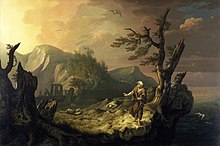
In the visual arts, Romanticism first showed itself in landscape painting, where from as early as the 1760s British artists began to turn to wilder landscapes and storms, and Gothic architecture, even if they had to make do with Wales as a setting. Caspar David Friedrich and J. M. W. Turner were born less than a year apart in 1774 and 1775 respectively and were to take German and English landscape painting to their extremes of Romanticism, but both their artistic sensibilities were formed when forms of Romanticism was already strongly present in art. John Constable, born in 1776, stayed closer to the English landscape tradition, but in his largest "six-footers" insisted on the heroic status of a patch of the working countryside where he had grown up—challenging the traditional hierarchy of genres, which relegated landscape painting to a low status. Turner also painted very large landscapes, and above all, seascapes. Some of these large paintings had contemporary settings and staffage, but others had small figures that turned the work into history painting in the manner of Claude Lorrain, like Salvator Rosa, a late Baroque artist whose landscapes had elements that Romantic painters repeatedly turned to. Friedrich often used single figures, or features like crosses, set alone amidst a huge landscape, "making them images of the transitoriness of human life and the premonition of death".[57]
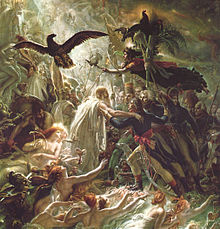
Other groups of artists expressed feelings that verged on the mystical, many largely abandoning classical drawing and proportions. These included William Blake and Samuel Palmer and the other members of the Ancients in England, and in Germany Philipp Otto Runge. Like Friedrich, none of these artists had significant influence after their deaths for the rest of the 19th century, and were 20th-century rediscoveries from obscurity, though Blake was always known as a poet, and Norway's leading painter Johan Christian Dahl was heavily influenced by Friedrich. The Rome-based Nazarene movement of German artists, active from 1810, took a very different path, concentrating on medievalizing history paintings with religious and nationalist themes.[58]
The arrival of Romanticism in French art was delayed by the strong hold of Neoclassicism on the academies, but from the Napoleonic period it became increasingly popular, initially in the form of history paintings propagandising for the new regime, of which Girodet's Ossian receiving the Ghosts of the French Heroes, for Napoleon's Château de Malmaison, was one of the earliest. Girodet's old teacher David was puzzled and disappointed by his pupil's direction, saying: "Either Girodet is mad or I no longer know anything of the art of painting".[59] A new generation of the French school,[60] developed personal Romantic styles, though still concentrating on history painting with a political message. Théodore Géricault (1791–1824) had his first success with The Charging Chasseur, a heroic military figure derived from Rubens, at the Paris Salon of 1812 in the years of the Empire, but his next major completed work, The Raft of the Medusa of 1818–19, remains the greatest achievement of the Romantic history painting, which in its day had a powerful anti-government message.
Eugène Delacroix (1798–1863) made his first Salon hits with The Barque of Dante (1822), The Massacre at Chios (1824) and Death of Sardanapalus (1827). The second was a scene from the Greek War of Independence, completed the year Byron died there, and the last was a scene from one of Byron's plays. With Shakespeare, Byron was to provide the subject matter for many other works of Delacroix, who also spent long periods in North Africa, painting colourful scenes of mounted Arab warriors. His Liberty Leading the People (1830) remains, with the Medusa, one of the best-known works of French Romantic painting. Both reflected current events, and increasingly "history painting", literally "story painting", a phrase dating back to the Italian Renaissance meaning the painting of subjects with groups of figures, long considered the highest and most difficult form of art, did indeed become the painting of historical scenes, rather than those from religion or mythology.[61]
Francisco Goya was called "the last great painter in whose art thought and observation were balanced and combined to form a faultless unity".[62] But the extent to which he was a Romantic is a complex question. In Spain, there was still a struggle to introduce the values of the Enlightenment, in which Goya saw himself as a participant. The demonic and anti-rational monsters thrown up by his imagination are only superficially similar to those of the Gothic fantasies of northern Europe, and in many ways he remained wedded to the classicism and realism of his training, as well as looking forward to the Realism of the later 19th century.[63] But he, more than any other artist of the period, exemplified the Romantic values of the expression of the artist's feelings and his personal imaginative world.[64] He also shared with many of the Romantic painters a more free handling of paint, emphasized in the new prominence of the brushstroke and impasto, which tended to be repressed in neoclassicism under a self-effacing finish.
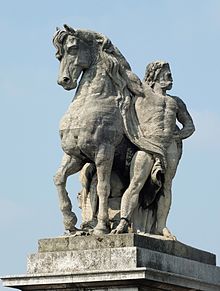
Sculpture remained largely impervious to Romanticism, probably partly for technical reasons, as the most prestigious material of the day, marble, does not lend itself to expansive gestures. The leading sculptors in Europe, Antonio Canova and Bertel Thorvaldsen, were both based in Rome and firm Neoclassicists, not at all tempted to allow influence from medieval sculpture, which would have been one possible approach to Romantic sculpture. When it did develop, true Romantic sculpture—with the exception of a few artists such as Rudolf Maison—[65] rather oddly was missing in Germany, and mainly found in France, with François Rude, best known from his group of the 1830s from the Arc de Triomphe in Paris, David d'Angers, and Auguste Préault. Préault's plaster relief entitled Slaughter, which represented the horrors of wars with exacerbated passion, caused so much scandal at the 1834 Salon that Préault was banned from this official annual exhibition for nearly twenty years.[66] In Italy, the most important Romantic sculptor was Lorenzo Bartolini.[67]
-
George Stubbs, A Lion Attacking a Horse (1770), oil on canvas, 38 in. x 49 1/2in., Yale Center for British Art
-
John Henry Fuseli, The Nightmare (1781), oil on canvas, 101.6 cm × 127 cm., Detroit Institute of Arts
In France, historical painting on idealized medieval and Renaissance themes is known as the style Troubadour, a term with no equivalent for other countries, though the same trends occurred there. Delacroix, Ingres and Richard Parkes Bonington all worked in this style, as did lesser specialists such as Pierre-Henri Révoil (1776–1842) and Fleury-François Richard (1777–1852). Their pictures are often small, and feature intimate private and anecdotal moments, as well as those of high drama. The lives of great artists such as Raphael were commemorated on equal terms with those of rulers, and fictional characters were also depicted. Fleury-Richard's Valentine of Milan weeping for the death of her husband, shown in the Paris Salon of 1802, marked the arrival of the style, which lasted until the mid-century, before being subsumed into the increasingly academic history painting of artists like Paul Delaroche.[68]


Another trend was for very large apocalyptic history paintings, often combining extreme natural events, or divine wrath, with human disaster, attempting to outdo The Raft of the Medusa, and now often drawing comparisons with effects from Hollywood. The leading English artist in the style was John Martin, whose tiny figures were dwarfed by enormous earthquakes and storms, and worked his way through the biblical disasters, and those to come in the final days. Other works such as Delacroix's Death of Sardanapalus included larger figures, and these often drew heavily on earlier artists, especially Poussin and Rubens, with extra emotionalism and special effects.
Elsewhere in Europe, leading artists adopted Romantic styles: in Russia there were the portraitists Orest Kiprensky and Vasily Tropinin, with Ivan Aivazovsky specializing in marine painting, and in Norway Hans Gude painted scenes of fjords. In Poland, Piotr Michałowski (1800–1855) used a Romantic style in paintings particularly relating to the history of Napoleonic Wars.[69] In Italy Francesco Hayez (1791–1882) was the leading artist of Romanticism in mid-19th-century Milan. His long, prolific and extremely successful career saw him begin as a Neoclassical painter, pass right through the Romantic period, and emerge at the other end as a sentimental painter of young women. His Romantic period included many historical pieces of "Troubadour" tendencies, but on a very large scale, that are heavily influenced by Gian Battista Tiepolo and other late Baroque Italian masters.
Literary Romanticism had its counterpart in the American visual arts, most especially in the exaltation of an untamed American landscape found in the paintings of the Hudson River School. Painters like Thomas Cole, Albert Bierstadt and Frederic Edwin Church and others often expressed Romantic themes in their paintings. They sometimes depicted ancient ruins of the old world, such as in Fredric Edwin Church's piece Sunrise in Syria. These works reflected the Gothic feelings of death and decay. They also show the Romantic ideal that Nature is powerful and will eventually overcome the transient creations of men. More often, they worked to distinguish themselves from their European counterparts by depicting uniquely American scenes and landscapes. This idea of an American identity in the art world is reflected in W. C. Bryant's poem To Cole, the Painter, Departing for Europe, where Bryant encourages Cole to remember the powerful scenes that can only be found in America.
Some American paintings (such as Albert Bierstadt's The Rocky Mountains, Lander's Peak) promote the literary idea of the "noble savage" by portraying idealized Native Americans living in harmony with the natural world. Thomas Cole's paintings tend towards allegory, explicit in The Voyage of Life series painted in the early 1840s, showing the stages of life set amidst an awesome and immense nature.
-
Thomas Cole, The Voyage of Life
Old Age (1842) -
William Blake, Albion Rose, 1794–95
-
Louis Janmot, from his series The Poem of the Soul, before 1854
Music[edit]
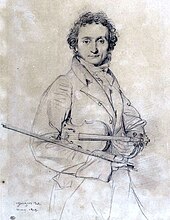
The term "Romanticism" when applied to music has come to imply the period roughly from 1800 until 1850, or else until around 1900. Musical Romanticism is predominantly a German phenomenon—so much so that one respected French reference work defines it entirely in terms of "The role of music in the aesthetics of German romanticism".[70] Another French encyclopedia holds that the German temperament generally "can be described as the deep and diverse action of romanticism on German musicians", and that there is only one true representative of Romanticism in French music, Hector Berlioz, while in Italy, the sole great name of musical Romanticism is Giuseppe Verdi, "a sort of [Victor] Hugo of opera, gifted with a real genius for dramatic effect". Similarly, in his analysis of Romanticism and its pursuit of harmony, Henri Lefebvre posits that, "But of course, German romanticism was more closely linked to music than French romanticism was, so it is there we should look for the direct expression of harmony as the central romantic idea."[71] Nevertheless, the huge popularity of German Romantic music led, "whether by imitation or by reaction", to an often nationalistically inspired vogue amongst Polish, Hungarian, Russian, Czech, and Scandinavian musicians, successful "perhaps more because of its extra-musical traits than for the actual value of musical works by its masters".[72]
In the contemporary music culture, the romantic musician followed a public career depending on sensitive middle-class audiences rather than on a courtly patron, as had been the case with earlier musicians and composers. Public persona characterized a new generation of virtuosi who made their way as soloists, epitomized in the concert tours of Paganini and Liszt, and the conductor began to emerge as an important figure, on whose skill the interpretation of the increasingly complex music depended.[73]
Evolution of the term in musicology[edit]

Although the term "Romanticism" when applied to music has come to imply the period roughly from 1800 until 1850, or else until around 1900, the contemporary application of "romantic" to music did not coincide with this modern interpretation. Indeed, one of the earliest sustained applications of the term to music occurs in 1789, in the Mémoires of André Grétry.[74] This is of particular interest because it is a French source on a subject mainly dominated by Germans, but also because it explicitly acknowledges its debt to Jean-Jacques Rousseau (himself a composer, amongst other things) and, by so doing, establishes a link to one of the major influences on the Romantic movement generally.[75] In 1810 E. T. A. Hoffmann named Haydn, Mozart and Beethoven as "the three masters of instrumental compositions" who "breathe one and the same romantic spirit". He justified his view on the basis of these composers' depth of evocative expression and their marked individuality. In Haydn's music, according to Hoffmann, "a child-like, serene disposition prevails", while Mozart (in the late E-flat major Symphony, for example) "leads us into the depths of the spiritual world", with elements of fear, love, and sorrow, "a presentiment of the infinite ... in the eternal dance of the spheres". Beethoven's music, on the other hand, conveys a sense of "the monstrous and immeasurable", with the pain of an endless longing that "will burst our breasts in a fully coherent concord of all the passions".[76] This elevation in the valuation of pure emotion resulted in the promotion of music from the subordinate position it had held in relation to the verbal and plastic arts during the Enlightenment. Because music was considered to be free of the constraints of reason, imagery, or any other precise concept, it came to be regarded, first in the writings of Wackenroder and Tieck and later by writers such as Schelling and Wagner, as preeminent among the arts, the one best able to express the secrets of the universe, to evoke the spirit world, infinity, and the absolute.[77]
This chronologic agreement of musical and literary Romanticism continued as far as the middle of the 19th century, when Richard Wagner denigrated the music of Meyerbeer and Berlioz as "neoromantic": "The Opera, to which we shall now return, has swallowed down the Neoromanticism of Berlioz, too, as a plump, fine-flavoured oyster, whose digestion has conferred on it anew a brisk and well-to-do appearance."[78]

It was only toward the end of the 19th century that the newly emergent discipline of Musikwissenschaft (musicology)—itself a product of the historicizing proclivity of the age—attempted a more scientific periodization of music history, and a distinction between Viennese Classical and Romantic periods was proposed. The key figure in this trend was Guido Adler, who viewed Beethoven and Franz Schubert as transitional but essentially Classical composers, with Romanticism achieving full maturity only in the post-Beethoven generation of Frédéric Chopin, Felix Mendelssohn, Robert Schumann, Hector Berlioz and Franz Liszt. From Adler's viewpoint, found in books like Der Stil in der Musik (1911), composers of the New German School and various late-19th-century nationalist composers were not Romantics but "moderns" or "realists" (by analogy with the fields of painting and literature), and this schema remained prevalent through the first decades of the 20th century.[75]
By the second quarter of the 20th century, an awareness that radical changes in musical syntax had occurred during the early 1900s caused another shift in historical viewpoint, and the change of century came to be seen as marking a decisive break with the musical past. This in turn led historians such as Alfred Einstein[79] to extend the musical "Romantic era" throughout the 19th century and into the first decade of the 20th. It has continued to be referred to as such in some of the standard music references such as The Oxford Companion to Music[80] and Grout's History of Western Music[81] but was not unchallenged. For example, the prominent German musicologist Friedrich Blume, the chief editor of the first edition of Die Musik in Geschichte und Gegenwart (1949–86), accepted the earlier position that Classicism and Romanticism together constitute a single period beginning in the middle of the 18th century, but at the same time held that it continued into the 20th century, including such pre-World War II developments as expressionism and neoclassicism.[82] This is reflected in some notable recent reference works such as the New Grove Dictionary of Music and Musicians[75] and the new edition of Musik in Geschichte und Gegenwart.[83]
-
Felix Mendelssohn, 1839
-
Robert Schumann, 1839
-
Franz Liszt, 1847
-
Daniel Auber, c. 1868
-
Hector Berlioz by Gustave Courbet, 1850
-
Giovanni Boldini, Portrait of Giuseppe Verdi, 1886
-
Richard Wagner, c. 1870s
-
Gustav Mahler, 1896
Outside the arts[edit]
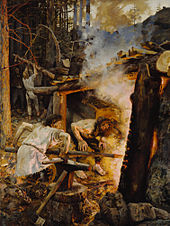
Sciences[edit]
The Romantic movement affected most aspects of intellectual life, and Romanticism and science had a powerful connection, especially in the period 1800–1840. Many scientists were influenced by versions of the Naturphilosophie of Johann Gottlieb Fichte, Friedrich Wilhelm Joseph von Schelling and Georg Wilhelm Friedrich Hegel and others, and without abandoning empiricism, sought in their work to uncover what they tended to believe was a unified and organic Nature. The English scientist Sir Humphry Davy, a prominent Romantic thinker, said that understanding nature required "an attitude of admiration, love and worship, [...] a personal response".[84] He believed that knowledge was only attainable by those who truly appreciated and respected nature. Self-understanding was an important aspect of Romanticism. It had less to do with proving that man was capable of understanding nature (through his budding intellect) and therefore controlling it, and more to do with the emotional appeal of connecting himself with nature and understanding it through a harmonious co-existence.[85]
Historiography[edit]
History writing was very strongly, and many would say harmfully, influenced by Romanticism.[86] In England, Thomas Carlyle was a highly influential essayist who turned historian; he both invented and exemplified the phrase "hero-worship",[87] lavishing largely uncritical praise on strong leaders such as Oliver Cromwell, Frederick the Great and Napoleon. Romantic nationalism had a largely negative effect on the writing of history in the 19th century, as each nation tended to produce its own version of history, and the critical attitude, even cynicism, of earlier historians was often replaced by a tendency to create romantic stories with clearly distinguished heroes and villains.[88] Nationalist ideology of the period placed great emphasis on racial coherence, and the antiquity of peoples, and tended to vastly overemphasize the continuity between past periods and the present, leading to national mysticism. Much historical effort in the 20th century was devoted to combating the romantic historical myths created in the 19th century.
Theology[edit]
To insulate theology from scientism or reductionism in science, 19th-century post-Enlightenment German theologians developed a modernist or so-called liberal conception of Christianity, led by Friedrich Schleiermacher and Albrecht Ritschl. They took the Romantic approach of rooting religion in the inner world of the human spirit, so that it is a person's feeling or sensibility about spiritual matters that comprises religion.[89]
Chess[edit]
Romantic chess was the style of chess which emphasized quick, tactical maneuvers characterized by aesthetic beauty rather than long-term strategic planning, which was considered to be of secondary importance.[90] The Romantic era in chess is generally considered to have begun around the 18th century (although a primarily tactical style of chess was predominant even earlier),[91] and to have reached its peak with Joseph MacDonnell and Pierre LaBourdonnais, the two dominant chess players in the 1830s. The 1840s were dominated by Howard Staunton, and other leading players of the era included Adolf Anderssen, Daniel Harrwitz, Henry Bird, Louis Paulsen, and Paul Morphy. The "Immortal Game", played by Anderssen and Lionel Kieseritzky on 21 June 1851 in London—where Anderssen made bold sacrifices to secure victory, giving up both rooks and a bishop, then his queen, and then checkmating his opponent with his three remaining minor pieces—is considered a supreme example of Romantic chess.[92] The end of the Romantic era in chess is considered to be the 1873 Vienna Tournament where Wilhelm Steinitz popularized positional play and the closed game.
Romantic nationalism[edit]
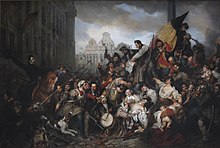
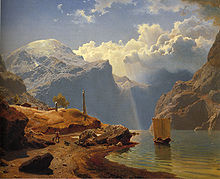
One of Romanticism's key ideas and most enduring legacies is the assertion of nationalism, which became a central theme of Romantic art and political philosophy. From the earliest parts of the movement, with their focus on development of national languages and folklore, and the importance of local customs and traditions, to the movements that would redraw the map of Europe and lead to calls for self-determination of nationalities, nationalism was one of the key vehicles of Romanticism, its role, expression and meaning. One of the most important functions of medieval references in the 19th century was nationalist. Popular and epic poetry were its workhorses. This is visible in Germany and Ireland, where underlying Germanic or Celtic linguistic substrates dating from before the Romanization-Latinization were sought out.
Early Romantic nationalism was strongly inspired by Rousseau, and by the ideas of Johann Gottfried von Herder, who in 1784 argued that the geography formed the natural economy of a people, and shaped their customs and society.[93]
The nature of nationalism changed dramatically, however, after the French Revolution with the rise of Napoleon, and the reactions in other nations. Napoleonic nationalism and republicanism were, at first, inspirational to movements in other nations: self-determination and a consciousness of national unity were held to be two of the reasons why France was able to defeat other countries in battle. But as the French Republic became Napoleon's Empire, Napoleon became not the inspiration for nationalism, but the object of its struggle. In Prussia, the development of spiritual renewal as a means to engage in the struggle against Napoleon was argued by, among others, Johann Gottlieb Fichte, a disciple of Kant. The word Volkstum, or nationality, was coined in German as part of this resistance to the now conquering emperor. Fichte expressed the unity of language and nation in his address "To the German Nation" in 1806:
Those who speak the same language are joined to each other by a multitude of invisible bonds by nature herself, long before any human art begins; they understand each other and have the power of continuing to make themselves understood more and more clearly; they belong together and are by nature one and an inseparable whole. ...Only when each people, left to itself, develops and forms itself in accordance with its own peculiar quality, and only when in every people each individual develops himself in accordance with that common quality, as well as in accordance with his own peculiar quality—then, and then only, does the manifestation of divinity appear in its true mirror as it ought to be.[94]
This view of nationalism inspired the collection of folklore by such people as the Brothers Grimm, the revival of old epics as national, and the construction of new epics as if they were old, as in the Kalevala, compiled from Finnish tales and folklore, or Ossian, where the claimed ancient roots were invented. The view that fairy tales, unless contaminated from outside literary sources, were preserved in the same form over thousands of years, was not exclusive to Romantic Nationalists, but fit in well with their views that such tales expressed the primordial nature of a people. For instance, the Brothers Grimm rejected many tales they collected because of their similarity to tales by Charles Perrault, which they thought proved they were not truly German tales;[95] Sleeping Beauty survived in their collection because the tale of Brynhildr convinced them that the figure of the sleeping princess was authentically German. Vuk Karadžić contributed to Serbian folk literature, using peasant culture as the foundation. He regarded the oral literature of the peasants as an integral part of Serbian culture, compiling it to use in his collections of folk songs, tales and proverbs, as well as the first dictionary of vernacular Serbian.[96] Similar projects were undertaken by the Russian Alexander Afanasyev, the Norwegians Peter Christen Asbjørnsen and Jørgen Moe, and the Englishman Joseph Jacobs.[97]
Polish nationalism and messianism[edit]

Romanticism played an essential role in the national awakening of many Central European peoples lacking their own national states, not least in Poland, which had recently failed to restore its independence when Russia's army crushed the Polish Uprising under Nicholas I. Revival and reinterpretation of ancient myths, customs and traditions by Romantic poets and painters helped to distinguish their indigenous cultures from those of the dominant nations and crystallise the mythography of Romantic nationalism. Patriotism, nationalism, revolution and armed struggle for independence also became popular themes in the arts of this period. Arguably, the most distinguished Romantic poet of this part of Europe was Adam Mickiewicz, who developed an idea that Poland was the Messiah of Nations, predestined to suffer just as Jesus had suffered to save all the people. The Polish self-image as a "Christ among nations" or the martyr of Europe can be traced back to its history of Christendom and suffering under invasions. During the periods of foreign occupation, the Catholic Church served as bastion of Poland's national identity and language, and the major promoter of Polish culture. The partitions came to be seen in Poland as a Polish sacrifice for the security for Western civilization. Adam Mickiewicz wrote the patriotic drama Dziady (directed against the Russians), where he depicts Poland as the Christ of Nations. He also wrote "Verily I say unto you, it is not for you to learn civilization from foreigners, but it is you who are to teach them civilization ... You are among the foreigners like the Apostles among the idolaters". In Books of the Polish Nation and Polish Pilgrimage Mickiewicz detailed his vision of Poland as a Messias and a Christ of Nations, that would save mankind. Dziady is known for various interpretation. The most known ones are the moral aspect of part II, individualist and romantic message of part IV, as well as deeply patriotic, messianistic and Christian vision in part III of the poem. Zdzisław Kępiński, however, focuses his interpretation on Slavic pagan and occult elements found in the drama. In his book Mickiewicz hermetyczny he writes about hermetic, theosophic and alchemical philosophy on the book as well as Masonic symbols.
Gallery[edit]
- Emerging Romanticism in the 18th century
-
Joseph Vernet, 1759, Shipwreck; the 18th-century "sublime"
-
Philip James de Loutherbourg, Coalbrookdale by Night, 1801, a key location of the English Industrial Revolution
- French Romantic painting
-
Eugène Delacroix, Collision of Moorish Horsemen, 1843–44
-
Eugène Delacroix, The Bride of Abydos, 1857, after the poem by Byron
- Other
-
Joseph Anton Koch, Waterfalls at Subiaco, 1812–1813, a "classical" landscape to art historians
-
James Ward, 1814–1815, Gordale Scar
-
John Constable, 1821, The Hay Wain, one of Constable's large "six footers"
-
J. C. Dahl, 1826, Eruption of Vesuvius, by Friedrich's closest follower
Romantic writers[edit]
- Manuel Antônio de Almeida
- Castro Alves
- Machado de Assis
- Casimiro de Abreu
- Nikoloz Baratashvili
- Gustavo Adolfo Bécquer
- William Blake
- Charlotte Brontë
- Emily Brontë
- Gonçalves Dias
- Anne Brontë
- Robert Burns
- Lord Byron
- Thomas Carlyle
- Alexander Chavchavadze
- Samuel Taylor Coleridge
- Emily Dickinson
- Alexandre Dumas
- Maria Edgeworth
- Joseph von Eichendorff
- Ralph Waldo Emerson
- Álvares de Azevedo
- Mihai Eminescu
- Ugo Foscolo
- Aleksander Fredro
- Johann Wolfgang von Goethe
- Nikolai Gogol
- Brothers Grimm
- Bernardo Guimarães
- Wilhelm Hauff
- Nathaniel Hawthorne
- E. T. A. Hoffmann
- Josiah Gilbert Holland
- Victor Hugo
- Washington Irving
- John Keats
- Zygmunt Krasiński
- Józef Ignacy Kraszewski
- Joaquim Manuel de Macedo
- Herman Melville
- Prosper Mérimée
- Adam Mickiewicz
- Novalis
- Cyprian Kamil Norwid
- Mikhail Lermontov
- Alessandro Manzoni
- Gérard de Nerval
- Grigol Orbeliani
- Petar II Petrović-Njegoš
- Laza Kostić
- Edgar Allan Poe
- Wincenty Pol
- Alexander Pushkin
- Ion Heliade Rădulescu
- Mary Robinson
- George Sand
- August Wilhelm von Schlegel
- Friedrich von Schlegel
- Walter Scott
- Mary Shelley
- Percy Bysshe Shelley
- Juliusz Słowacki
- Henry David Thoreau
- Fagundes Varela
- Wilhelm Heinrich Wackenroder
- William Wordsworth
Scholars of Romanticism[edit]
- Gerald Abraham
- M. H. Abrams
- Donald Ault
- Jacques Barzun
- Frederick C. Beiser
- Ian Bent
- Isaiah Berlin
- Tim Blanning
- Harold Bloom
- Friedrich Blume
- James Chandler
- Jeffrey N. Cox
- Carl Dahlhaus
- Northrop Frye
- Maria Janion
- Peter Kitson
- Philippe Lacoue-Labarthe
- Arthur Oncken Lovejoy
- Paul de Man
- Tilar J. Mazzeo
- Jerome McGann
- Anne K. Mellor
- Jean-Luc Nancy
- Ashton Nichols
- Leon Plantinga
- Christopher Ricks
- Charles Rosen
- René Wellek
- Susan J. Wolfson
See also[edit]
Related terms[edit]Opposing terms[edit] |
Related subjects[edit] |
Related movements[edit] |
|
References[edit]
Citations[edit]
- ^ Hamilton, Paul (2016). The Oxford Handbook of European Romanticism. Oxford: Oxford University Press. p. 170. ISBN 978-0-19-969638-3.
- ^ Blechman, Max (1999). Revolutionary Romanticism: A Drunken Boat Anthology. San Francisco, CA: City Lights Books. pp. 84–85. ISBN 0-87286-351-4.
- ^ Encyclopædia Britannica. "Romanticism. Retrieved 30 January 2008, from Encyclopædia Britannica Online". Britannica.com. Archived from the original on 13 October 2005. Retrieved 2010-08-24.
- ^ Casey, Christopher (October 30, 2008). ""Grecian Grandeurs and the Rude Wasting of Old Time": Britain, the Elgin Marbles, and Post-Revolutionary Hellenism". Foundations. Volume III, Number 1. Archived from the original on May 13, 2009. Retrieved 2014-05-14.
- ^ David Levin, History as Romantic Art: Bancroft, Prescott, and Parkman (1967)
- ^ Gerald Lee Gutek, A history of the Western educational experience (1987) ch. 12 on Johann Heinrich Pestalozzi
- ^ Ashton Nichols, "Roaring Alligators and Burning Tygers: Poetry and Science from William Bartram to Charles Darwin", Proceedings of the American Philosophical Society 2005 149(3): 304–15
- ^ Morrow, John (2011). "Romanticism and political thought in the early 19th century" (PDF). In Stedman Jones, Gareth; Claeys, Gregory (eds.). The Cambridge History of Nineteenth-Century Political Thought. The Cambridge History of Political Thought. Cambridge, United Kingdom: Cambridge University. pp. 39–76. doi:10.1017/CHOL9780521430562. ISBN 978-0-511-97358-1. Retrieved 10 September 2017.
- ^ Guliyeva, Gunesh (2022-12-15). "Traces of Romanticism in the Creativity of Bahtiyar Vahabzade" (PDF). Metafizika (in Azerbaijani). 5 (4): 77–87. eISSN 2617-751X. ISSN 2616-6879. OCLC 1117709579. Archived from the original (PDF) on 2022-11-14. Retrieved 2022-10-14.
- ^ Coleman, Jon T. (2020). Nature Shock: Getting Lost in America. Yale University Press. p. 214. ISBN 978-0-300-22714-7.
- ^ Barnes, Barbara A. (2006). Global Extremes: Spectacles of Wilderness Adventure, Endless Frontiers, and American Dreams. Santa Cruz: University of California Press. p. 51.
- ^ Perpinya, Núria. Ruins, Nostalgia and Ugliness. Five Romantic perceptions of Middle Ages and a spoon of Game of Thrones and Avant-garde oddity Archived 2016-03-13 at the Wayback Machine. Berlin: Logos Verlag. 2014
- ^ https://www.britannica.com/art/instrumentation-music/Post-Romanticism-in-the-20th-century-and-beyond
- ^ https://www.pristineclassical.com/products/pasc629
- ^ http://www.walking-tree.org/call/romantic_spirit_in_works_of_jrr_tolkien_CfP.pdf
- ^ Novotny, 96
- ^ From the Preface to the 2nd edition of Lyrical Ballads, quoted Day, 2
- ^ Day, 3
- ^ Ruthven (2001) p. 40 quote: "Romantic ideology of literary authorship, which conceives of the text as an autonomous object produced by an individual genius."
- ^ Spearing (1987) quote: "Surprising as it may seem to us, living after the Romantic movement has transformed older ideas about literature, in the Middle Ages authority was prized more highly than originality."
- ^ Eco (1994) p. 95 quote: Much art has been and is repetitive. The concept of absolute originality is a contemporary one, born with Romanticism; classical art was in vast measure serial, and the "modern" avant-garde (at the beginning of this century) challenged the Romantic idea of "creation from nothingness", with its techniques of collage, mustachios on the Mona Lisa, art about art, and so on.
- ^ Waterhouse (1926), throughout; Smith (1924); Millen, Jessica Romantic Creativity and the Ideal of Originality: A Contextual Analysis, in Cross-sections, The Bruce Hall Academic Journal – Volume VI, 2010 PDF Archived 2016-03-14 at the Wayback Machine; Forest Pyle, The Ideology of Imagination: Subject and Society in the Discourse of Romanticism (Stanford University Press, 1995) p. 28.
- ^ Breckman, Warren (2008). European Romanticism: A Brief History with Documents. Rogers D. Spotswood Collection. (1st ed.). Boston: Bedford/St. Martins. ISBN 978-0-312-45023-6. OCLC 148859077.
- ^ Berlin, 92
- ^ Day 3–4; quotation from M.H. Abrams, quoted in Day, 4
- ^ a b Schellinger, Paul (8 April 2014). "Novel and Romance: Etymologies". Encyclopedia of the Novel. Routledge. p. 942. ISBN 978-1-135-91826-2.
- ^ Saul, Nicholas (9 July 2009). The Cambridge Companion to German Romanticism. Cambridge University Press. pp. 1–. ISBN 978-0-521-84891-6.
- ^ Ferber, 6–7
- ^ Athenaeum. Bey F. Vieweg dem Älteren. 1800. p. 122.
Ich habe ein bestimmtes Merkmahl des Gegensatzes zwischen dem Antiken und dem Romantischen aufgestellt. Indessen bitte ich Sie doch, nun nicht sogleich anzunehmen, daß mir das Romantische und das Moderne völlig gleich gelte. Ich denke es ist etwa ebenso verschieden, wie die Gemählde des Raphael und Correggio von den Kupferstichen die jetzt Mode sind. Wollen Sie sich den Unterschied völlig klar machen, so lesen Sie gefälligst etwa die Emilia Galotti die so unaussprechlich modern und doch im geringsten nicht romantisch ist, und erinnern sich dann an Shakspeare, in den ich das eigentliche Zentrum, den Kern der romantischen Fantasie setzen möchte. Da suche und finde ich das Romantische, bey den ältern Modernen, bey Shakspeare, Cervantes, in der italiänischen Poesie, in jenem Zeitalter der Ritter, der Liebe und der Mährchen, aus welchem die Sache und das Wort selbst herstammt. Dieses ist bis jetzt das einzige, was einen Gegensatz zu den classischen Dichtungen des Alterthums abgeben kann; nur diese ewig frischen Blüthen der Fantasie sind würdig die alten Götterbilder zu umkränzen. Und gewiß ist es, daß alles Vorzüglichste der modernen Poesie dem Geist und selbst der Art nach dahinneigt; es müßte denn eine Rückkehr zum Antiken seyn sollen. Wie unsre Dichtkunst mit dem Roman, so fing die der Griechen mit dem Epos an und löste sich wieder darin auf.
- ^ a b Ferber, 7
- ^ Christiansen, 241.
- ^ Christiansen, 242.
- ^ in her Oxford Companion article, quoted by Day, 1
- ^ Day, 1–5
- ^ Mellor, Anne; Matlak, Richard (1996). British Literature 1780–1830. NY: Harcourt Brace & Co./Wadsworth. ISBN 978-1-4130-2253-7.
- ^ Edward F. Kravitt, The Lied: Mirror of Late Romanticism Archived 2022-12-04 at the Wayback Machine (New Haven and London: Yale University Press, 1996): 47. ISBN 0-300-06365-2.
- ^ Greenblatt et al., Norton Anthology of English Literature, eighth edition, "The Romantic Period – Volume D" (New York: W.W. Norton & Company Inc., 2006): [page needed]
- ^ Johnson, 147, inc. quotation
- ^ Barzun, 469
- ^ Day, 1–3; the arch-conservative and Romantic is Joseph de Maistre, but many Romantics swung from youthful radicalism to conservative views in middle age, for example Wordsworth. Samuel Palmer's only published text was a short piece opposing the Repeal of the corn laws.
- ^ Berlin, 57
- ^ Several of Berlin's pieces dealing with this theme are collected in the work referenced. See in particular: Berlin, 34–47, 57–59, 183–206, 207–37.
- ^ Berlin, 57–58
- ^ "Linda Simon The Sleep of Reason by Robert Hughes". 12 July 2021.
- ^ Three Critics of the Enlightenment: Vico, Hamann, Herder, Pimlico, 2000 ISBN 0-7126-6492-0 was one of Isaiah Berlin's many publications on the Enlightenment and its enemies that did much to popularise the concept of a Counter-Enlightenment movement that he characterised as relativist, anti-rationalist, vitalist and organic,
- ^ Darrin M. McMahon, "The Counter-Enlightenment and the Low-Life of Literature in Pre-Revolutionary France" Past and Present No. 159 (May 1998:77–112) p. 79 note 7.
- ^ "Baudelaire's speech at the "Salon des curiosités Estethiques" (in French). Fr.wikisource.org. Retrieved 2010-08-24.
- ^ Sutherland, James (1958) English Satire Archived 2022-12-04 at the Wayback Machine p. 1. There were a few exceptions, notably Byron, who integrated satire into some of his greatest works, yet shared much in common with his Romantic contemporaries. Bloom, p. 18.
- ^ Paul F. Grendler, Renaissance Society of America, Encyclopedia of the Renaissance, Scribner, 1999, p. 193
- ^ John Keats. By Sidney Colvin, p. 106. Elibron Classics
- ^ Thomas Chatterton, Grevel Lindop, 1972, Fyffield Books, p. 11
- ^ Weber, Patrick, Histoire de l'Architecture (2008), p. 63
- ^ a b Weber, Patrick, Histoire de l'Architecture (2008), pp. 64
- ^ a b Weber, Patrick, Histoire de l'Architecture (2008), pp. 64–65
- ^ Saule & Meyer 2014, p. 92.
- ^ Poisson & Poisson 2014.
- ^ Novotny, 96–101, 99 quoted
- ^ Novotny, 112–21
- ^ Honour, 184–190, 187 quoted
- ^ Walter Friedlaender, From David to Delacroix, 1974, remains the best available account of the subject.
- ^ "Romanticism". metmuseum.org.
- ^ Novotny, 142
- ^ Novotny, 133–42
- ^ Hughes, 279–80
- ^ McKay, James, The Dictionary of Sculptors in Bronze, Antique Collectors Club, London, 1995
- ^ Novotny, 397, 379–84
- ^ Dizionario di arte e letteratura. Bologna: Zanichelli. 2002. p. 544.
- ^ Noon, throughout, especially pp. 124–155
- ^ (in Polish) Masłowski, Maciej, Piotr Michałowski, Warszawa, 1957, Arkady Publishers, p. 6.
- ^ Boyer 1961, 585.
- ^ Lefebvre, Henri (1995). Introduction to Modernity: Twelve Preludes September 1959 – May 1961. London: Verso. p. 304. ISBN 1-85984-056-6.
- ^ Ferchault 1957.
- ^ Christiansen, 176–78.
- ^ Grétre 1789.
- ^ a b c Samson 2001.
- ^ Hoffmann 1810, col. 632.
- ^ Boyer 1961, 585–86.
- ^ Wagner 1995, 77.
- ^ Einstein 1947.
- ^ Warrack 2002.
- ^ Grout 1960, 492.
- ^ Blume 1970; Samson 2001.
- ^ Wehnert 1998.
- ^ Cunningham, A., and Jardine, N., ed. Romanticism and the Sciences, p. 15.
- ^ Bossi, M., and Poggi, S., ed. Romanticism in Science: Science in Europe, 1790–1840, p.xiv; Cunningham, A., and Jardine, N., ed. Romanticism and the Sciences, p. 2.
- ^ E. Sreedharan (2004). A Textbook of Historiography, 500 B.C. to A.D. 2000. Orient Blackswan. pp. 128–68. ISBN 978-81-250-2657-0.
- ^ in his published lectures On Heroes, Hero-Worship, and The Heroic in History of 1841
- ^ Ceri Crossley (2002). French Historians and Romanticism: Thierry, Guizot, the Saint-Simonians, Quinet, Michelet. Routledge. ISBN 978-1-134-97668-3.
- ^ Philip Clayton and Zachary Simpson, eds. The Oxford Handbook of Religion and Science (2006) p. 161
- ^ David Shenk (2007). The Immortal Game: A History of Chess. Knopf Doubleday. p. 99. ISBN 978-0-307-38766-0.
- ^ Swaner, Billy (2021-01-08). "Chess History Guide : Chess Style Evolution". Chess Game Strategies. Retrieved 2021-04-20.
- ^ Hartston, Bill (1996). Teach Yourself Chess. Hodder & Stoughton. p. 150. ISBN 978-0-340-67039-2.
- ^ Hayes, Carlton (July 1927). "Contributions of Herder to the Doctrine of Nationalism". The American Historical Review. 32 (4): 722–723. doi:10.2307/1837852. JSTOR 1837852.
- ^ Fichte, Johann (1806). "Address to the German Nation". Fordham University. Archived from the original on August 14, 2014. Retrieved October 1, 2013.
- ^ Maria Tatar, The Hard Facts of the Grimms' Fairy Tales, p. 31 ISBN 0-691-06722-8
- ^ Prilozi za književnost, jezik, istoriju i folklor (in Serbian). Државна штампарија Краљевине Срба, Хрвата и Словенаца. 1965. p. 264. Retrieved 19 January 2012.
- ^ Jack Zipes, The Great Fairy Tale Tradition: From Straparola and Basile to the Brothers Grimm, p. 846, ISBN 0-393-97636-X
Sources[edit]
- Adler, Guido. 1911. Der Stil in der Musik. Leipzig: Breitkopf & Härtel.
- Adler, Guido. 1919. Methode der Musikgeschichte. Leipzig: Breitkopf & Härtel.
- Adler, Guido. 1930. Handbuch der Musikgeschichte, second, thoroughly revised and greatly expanded edition. 2 vols. Berlin-Wilmersdorf: H. Keller. Reprinted, Tutzing: Schneider, 1961.
- Barzun, Jacques. 2000. From Dawn to Decadence: 500 Years of Western Cultural Life, 1500 to the Present. ISBN 978-0-06-092883-4.
- Berlin, Isaiah. 1990. The Crooked Timber of Humanity: Chapters in the History of Ideas, ed. Henry Hardy. London: John Murray. ISBN 0-7195-4789-X.
- Bloom, Harold (ed.). 1986. George Gordon, Lord Byron. New York: Chelsea House Publishers.
- Blume, Friedrich. 1970. Classic and Romantic Music, translated by M. D. Herter Norton from two essays first published in Die Musik in Geschichte und Gegenwart. New York: W.W. Norton.
- Black, Joseph, Leonard Conolly, Kate Flint, Isobel Grundy, Don LePan, Roy Liuzza, Jerome J. McGann, Anne Lake Prescott, Barry V. Qualls, and Claire Waters. 2010. The Broadview Anthology of British Literature Volume 4: The Age of Romanticism Second Edition[permanent dead link]. Peterborough: Broadview Press. ISBN 978-1-55111-404-0.
- Bowra, C. Maurice. 1949. The Romantic Imagination (in series, "Galaxy Book[s]"). New York: Oxford University Press.
- Boyer, Jean-Paul. 1961. "Romantisme". Encyclopédie de la musique, edited by François Michel, with François Lesure and Vladimir Fédorov, 3:585–87. Paris: Fasquelle.
- Christiansen, Rupert. 1988. Romantic Affinities: Portraits From an Age, 1780–1830. London: Bodley Head. ISBN 0-370-31117-5. Paperback reprint, London: Cardinal, 1989 ISBN 0-7474-0404-6. Paperback reprint, London: Vintage, 1994. ISBN 0-09-936711-4. Paperback reprint, London: Pimlico, 2004. ISBN 1-84413-421-0.
- Cunningham, Andrew, and Nicholas Jardine (eds.) (1990). Romanticism and the Sciences. Cambridge and New York: Cambridge University Press. ISBN 0-521-35602-4 (cloth); ISBN 0-521-35685-7 (pbk.); another excerpt-and-text-search source Archived 2022-12-04 at the Wayback Machine.
- Day, Aidan. Romanticism, 1996, Routledge, ISBN 0-415-08378-8, 978-0-415-08378-2.
- Eco, Umberto. 1994. "Interpreting Serials", in his The Limits of Interpretation Archived 2022-12-04 at the Wayback Machine, pp. 83–100. Bloomington: Indiana University Press. ISBN 0-253-20869-6. excerpt Archived 2011-07-21 at the Wayback Machine
- Einstein, Alfred. 1947. Music in the Romantic Era. New York: W.W. Norton.
- Ferber, Michael. 2010. Romanticism: A Very Short Introduction. Oxford and New York: Oxford University Press. ISBN 978-0-19-956891-8.
- Friedlaender, Walter, David to Delacroix, (Originally published in German; reprinted 1980) 1952.[full citation needed]
- Greenblatt, Stephen, M. H. Abrams, Alfred David, James Simpson, George Logan, Lawrence Lipking, James Noggle, Jon Stallworthy, Jahan Ramazani, Jack Stillinger, and Deidre Shauna Lynch. 2006. Norton Anthology of English Literature, eighth edition, The Romantic Period – Volume D. New York: W.W. Norton & Company, Inc. ISBN 978-0-393-92720-7.
- Grétry, André-Ernest-Modeste. 1789. Mémoires, ou Essai sur la musique. 3 vols. Paris: Chez l'auteur, de L'Imprimerie de la république, 1789. Second, enlarged edition, Paris: Imprimerie de la république, pluviôse, 1797. Republished, 3 vols., Paris: Verdiere, 1812; Brussels: Whalen, 1829. Facsimile of the 1797 edition, Da Capo Press Music Reprint Series. New York: Da Capo Press, 1971. Facsimile reprint in 1 volume of the 1829 Brussels edition, Bibliotheca musica Bononiensis, Sezione III no. 43. Bologna: Forni Editore, 1978.
- Grout, Donald Jay. 1960. A History of Western Music. New York: W.W. Norton & Company, Inc.
- Hoffmann, Ernst Theodor Amadeus. 1810. "Recension: Sinfonie pour 2 Violons, 2 Violes, Violoncelle e Contre-Violon, 2 Flûtes, petite Flûte, 2 Hautbois, 2 Clarinettes, 2 Bassons, Contrabasson, 2 Cors, 2 Trompettes, Timbales et 3 Trompes, composée et dediée etc. par Louis van Beethoven. à Leipsic, chez Breitkopf et Härtel, Oeuvre 67. No. 5. des Sinfonies. (Pr. 4 Rthlr. 12 Gr.)". Allgemeine musikalische Zeitung 12, no. 40 (4 July), cols. 630–42 [Der Beschluss folgt.]; 12, no. 41 (11 July), cols. 652–59.
- Honour, Hugh, Neo-classicism, 1968, Pelican.
- Hughes, Robert. Goya. New York: Alfred A. Knopf, 2004. ISBN 0-394-58028-1.
- Joachimides, Christos M. and Rosenthal, Norman and Anfam, David and Adams, Brooks (1993) American Art in the 20th Century: Painting and Sculpture 1913–1993 Archived 2022-12-04 at the Wayback Machine.
- Macfarlane, Robert. 2007. 'Romantic' Originality Archived 2011-07-21 at the Wayback Machine, in Original Copy: Plagiarism and Originality in Nineteenth-Century Literature Archived 2022-12-04 at the Wayback Machine, March 2007, pp. 18–50(33)
- (in Polish) Masłowski, Maciej, Piotr Michałowski, Warszawa, 1957, Arkady Publishers
- Noon, Patrick (ed), Crossing the Channel, British and French Painting in the Age of Romanticism, 2003, Tate Publishing/Metropolitan Museum of Art.
- Novotny, Fritz, Painting and Sculpture in Europe, 1780–1880 (Pelican History of Art), Yale University Press, 2nd edn. 1971 ISBN 0-14-056120-X.
- Ruthven, Kenneth Knowles. 2001. Faking Literature. Cambridge and New York: Cambridge University Press. ISBN 0-521-66015-7, 0-521-66965-0.
- Poisson, Georges; Poisson, Olivier (2014). Eugène Viollet-le-Duc (in French). Paris: Picard. ISBN 978-2-7084-0952-1.
- Samson, Jim. 2001. "Romanticism". The New Grove Dictionary of Music and Musicians, second edition, edited by Stanley Sadie and John Tyrrell. London: Macmillan Publishers.
- Saule, Béatrix; Meyer, Daniel (2014). Versailles Visitor's Guide. Versailles: Éditions Art-Lys. ISBN 9782854951172.
- Smith, Logan Pearsall (1924) Four Words: Romantic, Originality, Creative, Genius. Oxford: Clarendon Press.
- Spearing, A. C. 1987. Introduction section to Chaucer's The Franklin's Prologue and Tale[full citation needed]
- Steiner, George. 1998. "Topologies of Culture", chapter 6 of After Babel: Aspects of Language and Translation, third revised edition. Oxford and New York: Oxford University Press. ISBN 978-0-19-288093-2.
- Wagner, Richard. Opera and Drama, translated by William Ashton Ellis. Lincoln: University of Nebraska Press, 1995. Originally published as volume 2 of Richard Wagner's Prose Works (London: Kegan Paul, Trench, Trubner & Co., 1900), a translation from Gesammelte Schriften und Dichtungen (Leipzig, 1871–73, 1883).
- Warrack, John. 2002. "Romanticism". The Oxford Companion to Music, edited by Alison Latham. Oxford and New York: Oxford University Press. ISBN 0-19-866212-2.
- Waterhouse, Francis A. 1926. Romantic 'Originality' Archived 2016-05-06 at the Wayback Machine in The Sewanee Review, Vol. 34, No. 1 (January 1926), pp. 40–49.
- Weber, Patrick, Histoire de l'Architecture de l'Antiquité à Nos Jours, Librio, Paris, (2008) ISBN 978-229-0-158098.
- Wehnert, Martin. 1998. "Romantik und romantisch". Die Musik in Geschichte und Gegenwart: allgemeine Enzyklopädie der Musik, begründet von Friedrich Blume, second revised edition. Sachteil 8: Quer–Swi, cols. 464–507. Basel, Kassel, London, Munich, and Prague: Bärenreiter; Stuttgart and Weimar: Metzler.
Further reading[edit]
This 'further reading' section may need cleanup. (February 2024) |
- Abrams, Meyer H. 1971. The Mirror and the Lamp. London: Oxford University Press. ISBN 0-19-501471-5.
- Abrams, Meyer H. 1973. Natural Supernaturalism: Tradition and Revolution in Romantic Literature. New York: W. W. Norton.
- Barzun, Jacques. 1943. Romanticism and the Modern Ego. Boston: Little, Brown and Company.
- Barzun, Jacques. 1961. Classic, Romantic, and Modern. University of Chicago Press. ISBN 978-0-226-03852-0.
- Berlin, Isaiah. 1999. The Roots of Romanticism. London: Chatto and Windus. ISBN 0-691-08662-1.
- Blanning, Tim. The Romantic Revolution: A History (2011).
- Breckman, Warren, European Romanticism: A Brief History with Documents. New York: Bedford/St. Martin's, 2007. Breckman, Warren (2008). European Romanticism: A Brief History with Documents. Bedford/St. Martin's. ISBN 978-0-312-45023-6.
- Cavalletti, Carlo. 2000. Chopin and Romantic Music, translated by Anna Maria Salmeri Pherson. Hauppauge, New York: Barron's Educational Series. ISBN 0-7641-5136-3, 978-0-7641-5136-1.
- Chaudon, Francis. 1980. The Concise Encyclopedia of Romanticism. Secaucus, N.J.: Chartwell Books. ISBN 0-89009-707-0.
- Ciofalo, John J. 2001. "The Ascent of Genius in the Court and Academy." The Self-Portraits of Francisco Goya. Cambridge University Press.
- Clewis, Robert R., ed. The Sublime Reader. London: Bloomsbury Academic, 2019.
- Cox, Jeffrey N. 2004. Poetry and Politics in the Cockney School: Keats, Shelley, Hunt and Their Circle. Cambridge University Press. ISBN 978-0-521-60423-9.
- Dahlhaus, Carl. 1979. "Neo-Romanticism". 19th-Century Music 3, no. 2 (November): 97–105.
- Dahlhaus, Carl. 1980. Between Romanticism and Modernism: Four Studies in the Music of the Later Nineteenth Century, translated by Mary Whittall in collaboration with Arnold Whittall; also with Friedrich Nietzsche, "On Music and Words", translated by Walter Arnold Kaufmann. California Studies in 19th Century Music 1. Berkeley: University of California Press. ISBN 0-520-03679-4, 0-520-06748-7. Original German edition, as Zwischen Romantik und Moderne: vier Studien zur Musikgeschichte des späteren 19. Jahrhunderts. Munich: Musikverlag Katzber, 1974.
- Dahlhaus, Carl. 1985. Realism in Nineteenth-Century Music, translated by Mary Whittall. Cambridge and New York: Cambridge University Press. ISBN 0-521-26115-5, 0-521-27841-4. Original German edition, as Musikalischer Realismus: zur Musikgeschichte des 19. Jahrhunderts. Munich: R. Piper, 1982. ISBN 3-492-00539-X.
- Fabre, Côme, and Felix Krämer (eds.). 2013. L'ange du bizarre: Le romantisme noire de Goya a Max Ernst, à l'occasion de l'Exposition, Stadel Museum, Francfort, 26 septembre 2012 – 20 janvier 2013, Musée d'Orsay, Paris, 5 mars – 9 juin 2013. Ostfildern: Hatje Cantz. ISBN 978-3-7757-3590-2.
- Fay, Elizabeth. 2002. Romantic Medievalism. History and the Romantic Literary Ideal. Houndsmills, Basingstoke: Palgrave.
- Garofalo, Piero. 2005. "Italian Romanticisms." Companion to European Romanticism, ed. Michael Ferber. London: Blackwell Press, 238–255.
- Gaull, Marilyn. 1988. English Romanticism: The Human Context. New York and London: W. W. Norton. ISBN 978-0-393-95547-7.
- Gay, Peter. 2015. Why the Romantics Matter. New Haven, Connecticut: Yale University Press. ISBN 978-0300144291.
- Geck, Martin. 1998. "Realismus". Die Musik in Geschichte und Gegenwart: Allgemeine Enzyklopädie der Musik begründe von Friedrich Blume, second, revised edition, edited by Ludwig Finscher. Sachteil 8: Quer–Swi, cols. 91–99. Kassel, Basel, London, New York, Prague: Bärenreiter; Suttgart and Weimar: Metzler. ISBN 3-7618-1109-8 (Bärenreiter); ISBN 3-476-41008-0 (Metzler).
- Grewe, Cordula. 2009. Painting the Sacred in the Age of German Romanticism. Burlington: Ashgate. Grewe, Cordula (2009). Painting the Sacred in the Age of Romanticism. Ashgate Publishing. ISBN 978-0-7546-0645-1.
- Halmi, Nicholas. 2019. "European Romanticism." In The Cambridge History of Modern European Thought, ed. Warren Breckman and Peter Gordon, vol. 1, 40-64. Cambridge: Cambridge University Press. ISBN 9781107097759.[1]
- Halmi, Nicholas. 2021. "Romantic Thinking." In Thought: A Philosophical History, ed. Daniel Whistler and Panayiota Vassilopoulou, 61-74. ISBN 9780367000103.[2]
- Halmi, Nicholas. 2023. "Transcendental Revolutions." In The Cambridge History of European Romantic Literature, ed. Patrick Vincent, 223-54. Cambridge: Cambridge University Press. ISBN 9781108497060 [3]
- Hamilton, Paul, ed. The Oxford Handbook of European Romanticism (2016).
- Hesmyr, Atle. 2018. From Enlightenment to Romanticism in 18th Century Europe
- Holmes, Richard. 2009. The Age of Wonder: How the Romantic Generation Discovered the Beauty and Terror of Science. London: HarperPress. ISBN 978-0-00-714952-0. New York: Pantheon Books. ISBN 978-0-375-42222-5. Paperback reprint, New York: Vintage Books. ISBN 978-1-4000-3187-0
- Honour, Hugh. 1979. Romanticism. New York: Harper and Row. ISBN 0-06-433336-1, 0-06-430089-7.
- Kravitt, Edward F. 1992. "Romanticism Today". The Musical Quarterly 76, no. 1 (Spring): 93–109.
- Lang, Paul Henry. 1941. Music in Western Civilization. New York: W.W. Norton
- McCalman, Iain (ed.). 2009. An Oxford Companion to the Romantic Age. Oxford and New York: Oxford University Press. Online at Oxford Reference Online (subscription required)
- Mason, Daniel Gregory. 1936. The Romantic Composers. New York: Macmillan.
- Masson, Scott. 2007. "Romanticism", Chapt. 7 in The Oxford Handbook of English Literature and Theology, (Oxford University Press).
- Murray, Christopher, ed. Encyclopedia of the romantic era, 1760–1850 (2 vol 2004); 850 articles by experts; 1600pp
- Mazzeo, Tilar J. 2006. Plagiarism and Literary Property in the Romantic Period. University of Pennsylvania Press. ISBN 978-0-812-20273-1
- O'Neill, J, ed. (2000). Romanticism & the school of nature : nineteenth-century drawings and paintings from the Karen B. Cohen collection. New York: The Metropolitan Museum of Art.
- Plantinga, Leon. 1984. Romantic Music: A History of Musical Style in Nineteenth-Century Europe. A Norton Introduction to Music History. New York: W.W. Norton. ISBN 0-393-95196-0, 978-0-393-95196-7
- Reynolds, Nicole. 2010. Building Romanticism: Literature and Architecture in Nineteenth-century Britain. University of Michigan Press. ISBN 978-0-472-11731-4.
- Riasanovsky, Nicholas V. 1992. The Emergence of Romanticism. New York: Oxford University Press. ISBN 978-0-19-507341-6
- Rosen, Charles. 1995. The Romantic Generation. Cambridge, Massachusetts: Harvard University Press. ISBN 0-674-77933-9.
- Rosenblum, Robert, Modern Painting and the Northern Romantic Tradition: Friedrich to Rothko, (Harper & Row) 1975.
- Rummenhöller, Peter. 1989. Romantik in der Musik: Analysen, Portraits, Reflexionen. Munich: Deutscher Taschenbuch Verlag; Kassel and New York: Bärenreiter.
- Ruston, Sharon. 2013. Creating Romanticism: Case Studies in the Literature, Science and Medicine of the 1790s. Palgrave Macmillan. ISBN 978-1-137-26428-2.
- Schenk, H. G. 1966. The Mind of the European Romantics: An Essay in Cultural History. [full citation needed]: Constable.
- Spencer, Stewart. 2008. "The 'Romantic Operas' and the Turn to Myth". In The Cambridge Companion to Wagner, edited by Thomas S. Grey, 67–73. Cambridge and New York: Cambridge University Press. ISBN 0-521-64299-X, 0-521-64439-9.
- Tekiner, Deniz. 2000. Modern Art and the Romantic Vision. Lanham, Maryland. University Press of America. ISBN 978-0-7618-1528-0, 978-0-7618-1529-7.
- Tong, Q. S. 1997. Reconstructing Romanticism: Organic Theory Revisited. Poetry Salzburg.
- Turley, Richard Marggraf. 2002. The Politics of Language in Romantic Literature. London. Palgrave Macmillan. ISBN 978-0-7618-1528-0.
- Workman, Leslie J. 1994. "Medievalism and Romanticism". Poetica 39–40: 1–34.
- Wulf, Andrea. 2022. Magnificent Rebels: The First Romantics and the Invention of the Self. Knopf.
External links[edit]
- Romantics & Victorians Archived 2016-07-01 at the Wayback Machine explored on the British Library Discovering Literature website
- The Romantic Poets
- The Great Romantics
- "Romanticism", Dictionary of the History of Ideas
- "Romanticism in Political Thought", Dictionary of the History of Ideas
- Romantic Circles—Electronic editions, histories, and scholarly articles related to the Romantic era
- Romantic Rebellion


